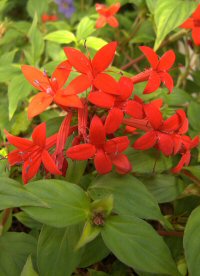New cultivar names we are allocating or introducing 2016
Not only as we have done in the past to conform with international nomenclature rules, but to conform with The Convention on Biological Diversity (CBD) and The Nagoya Protocol. We are only allowed to apply cultivar names to collected material or their progeny including hybrids, with the agreement of the host country. Hence this year the emphasis is on Aspidistra, as we have an agreement with Taiwan.
 |
Aspidistra attenuata ’Dungpu Dazzler’ Possibly the most floriferous selection of any species in cultivation, of this so familiar evergreen perennial arising from thickened creeping scaly rhizomes. Originating from a collection BSWJ377 we gathered on our first expedition to Taiwan in 1992, from a very well drained densely shady area near the village of Dungpu (Tungpu). Situated at the base of Yushan, Taiwan's highest mountain, which is part of their Central Mountain Range. Where it forms dense colonies of long petioles, bearing long glossy deep green, yellow to white spotted leaves to around a meter tall by 10-15cm wide. In this form the pale yellow tubular-campanulate flowers with 7-8 reflexed lobes are produced in ridiculous quantities, capable of carpeting the ground in warm conditions October to January. The flowers like most other species are borne just above ground level and can be followed by large globose rough textured berries. The stigma of this species is easily identifiable looking like a blown out umbrella.
|

|
Aspidistra attenuata ’Xitou Starlet’ Originating from one of our collections BSWJ2001 from the Xitou (Hsitou old spelling)(pronounced Shi-toe) Experimental Forest, part of The Taiwan National University during the winter of 1993. Where it formed a large colony which enveloped a huge boulder, only obtaining moisture from the debris and leafmould accumulated above its rhizomes. With faintly spotted and streaked leaves to around 1m long held on short petioles encased in a purple sheath, bearing purple-yellow edged flowers at ground level.
|
 |
Aspidistra daibuensis ’Taiwan Stars’ Evergreen perennial, arising from strong creeping densely scaly rhizomes, in time forming dense colonies of broadly lanceolate glossy deep green leaves, with few sometimes pale yellow spots, to around a meter tall. Originating from one of our collections BSWJ312b from a very well drained densely shady area on the South Cross Highway, in Taiwan on our first expedition there in 1992. Annually producing yellowish tinted campanulate purple-pink 8-rayed flowers at ground level, followed by a globose green berry. Flowering in early winter for us, as well as in North Carolina (Tony Avent), where the flowering is abundant in their hotter climate.
|
 |
Aspidistra daibuensis ’Yuli Yummy’ From one of our collections BSWJ6863, gathered from Yuli in southern Taiwan in 1999. This form was distinct amongst the many colonies we found growing in the shaded areas of the dry valley, by the tall to 1m long oblong-lanceolate leaves being more heavily spotted and streaked in white than any others in this area. Bearing its unusual red-purple 8-lobbed starry flowers with dark interiors and creamy tipped lobes at ground level in mid to late-winter for us.
|

|
Aspidistra sutepensis 'Pha-Hom Pok-Adot' Originating from one of our collections BSWJ6645 gathered in 1998. From almost at the summit of the remote Doi Pha-Hom Pok, Thailand's second highest peak at 2250m, straddling the border with Myanmar, all within the infamous Golden Triangle. Where it formed a large scattered colony of unusually lightly mottled and faintly striped leaves, which only had short petioles bearing the broadly elliptic arching leaves. Spreading from a thick rhizome with the distinct purple 8-9 lobbed campanulate flower at ground level August to October for us, sometimes followed by large orbicular fruit.
|
 |
Crusea coccinea 'Crûg Crimson' From a family of plants seldom seen as possessing any hardiness in the UK, Rubiaceae. A low growing creeping woodlander with fresh green small ribbed leaves on slender rooting reddish stems. Bearing bright red long trumpet-flowers in axillary clusters for months during the summer. Originating from one of our collections BSWJ10254 gathered from the high mountain forests of Oaxaca southern Mexico in 2004. Easily grown in full to part shade in a freely drained soil with some humus for moisture retention, or in a container.
|
 |
Magnolia floribunda ’Fansipan Furry’ Looking to us like a completley different species, when we found this unusual form with exceptionally hairy young stems, but we have been reassured that is within the scope of this species. From our collection FMWJ13384 gathered from a remote valley in the Hoang Lien Mountain Range in northern Vietnam in the autumn of 2011, on a trail leading to Fansipan, the highest mountain in northern Vietnam.
|